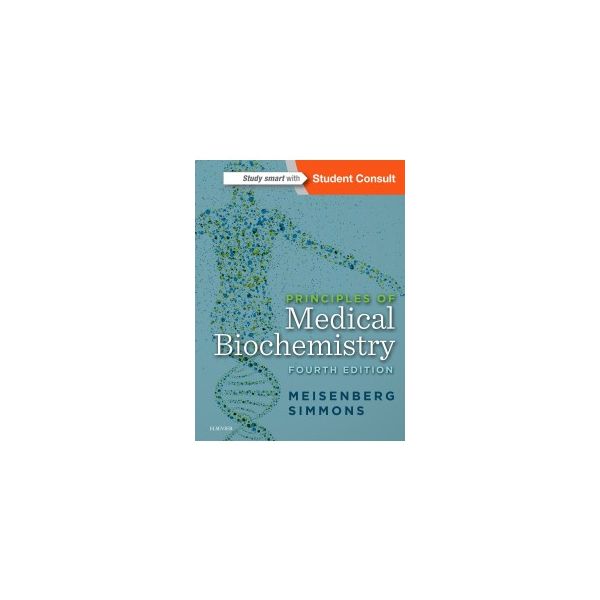Principles of Medical Biochemistry 4E
For nearly 30 years, Principles of Medical Biochemistry has integrated medical biochemistry with molecular genetics, cell biology, and genetics to provide complete yet concise coverage that links biochemistry with clinical medicine. The 4th Edition of this award-winning text by Drs. Gerhard Meisenberg and William H. Simmons has been fully updated with new clinical examples, expanded coverage of recent changes in the field, and many new case studies online. A highly visual format helps readers retain complex information, and USMLE-style questions (in print and online) assist with exam preparation.
| Author | Meisenberg, Simmons |
|---|---|
| Table Of Content | Part ONE PRINCIPLES OF MOLECULAR STRUCTURE AND FUNCTION 1 Chapter 1 INTRODUCTION TO BIOMOLECULES Water Is the Solvent of Life Water Contains Hydronium Ions and Hydroxyl Ions Ionizable Groups Are Characterized by Their pK Values The Blood pH is Tightly Regulated Acidosis and Alkalosis Are Common in Clinical Practice Bonds Are Formed by Reactions between Functional Groups Isomeric Forms Are Common in Biomolecules Properties of Biomolecules Are Determined by Their Noncovalent Interactions Triglycerides Consist of Fatty Acids and Glycerol Monosaccharides Are Polyalcohols with a Keto Group or an Aldehyde Group Monosaccharides Form Ring Structures Complex Carbohydrates Are Formed by Glycosidic Bonds Polypeptides Are Formed from Amino Acids Nucleic Acids Are Formed from Nucleotides Most Biomolecules Are Polymers Summary Chapter 2 INTRODUCTION TO PROTEIN STRUCTURE Amino Acids Are Zwitterions Amino Acid Side Chains Form Many Noncovalent Interactions Peptide Bonds and Disulfide Bonds Form the Primary Structure of Proteins Proteins Can Fold Themselves into Many Shapes ?-Helix and ?-Pleated Sheet Are the Most Common Secondary Structures in Proteins Globular Proteins Have a Hydrophobic Core Proteins Lose Their Biological Activities When Their Higher-Order Structure Is Destroyed The Solubility of Proteins Depends on pH and Salt Concentration Proteins Absorb Ultraviolet Radiation Proteins Can Be Separated by Their Charge or Their Molecular Weight Abnormal Protein Aggregates Can Cause Disease Neurodegenerative Diseases Are Caused by Protein Aggregates Protein Misfolding Can Be Contagious Summary Chapter 3 OXYGEN TRANSPORTERS: HEMOGLOBIN AND MYOGLOBIN The Heme Group Is the Oxygen-Binding Site of Hemoglobin and Myoglobin Myoglobin Is a Tightly Packed Globular Protein Red Blood Cells Are Specialized for Oxygen Transport The Hemoglobins Are Tetrameric Proteins Oxygenated and Deoxygenated Hemoglobin Have Different Quaternary Structures Oxygen Binding to Hemoglobin Is Cooperative 2,3-Bisphosphoglycerate Is a Negative Allosteric Effector of Oxygen Binding to Hemoglobin Fetal Hemoglobin Has a Higher Oxygen-Binding Affinity than Does Adult Hemoglobin The Bohr Effect Facilitates Oxygen Delivery Most Carbon Dioxide Is Transported as Bicarbonate Summary 38 Chapter 4 ENZYMATIC REACTIONS 39 The Equilibrium Constant Describes the Equilibrium of the Reaction The Free Energy Change Is the Driving Force for Chemical Reactions The Standard Free Energy Change Determines the Equilibrium Enzymes Are Both Powerful and Selective The Substrate Must Bind to Its Enzyme before the Reaction Can Proceed Rate Constants Are Useful for Describing Reaction Rates Enzymes Decrease the Free Energy of Activation Many Enzymatic Reactions Can Be Described by Michaelis-Menten Kinetics K mandVmaxCan Be Determined Graphically |
| Publish Date | 28 Nov 2016 |





